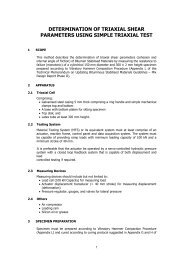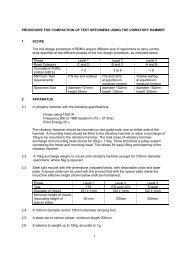Updating Bituminous Stabilized Materials Guidelines Mix Design Report Phase II
Moisture Sensitivity: Part II (Validation) - Asphalt Academy
Moisture Sensitivity: Part II (Validation) - Asphalt Academy
- No tags were found...
Create successful ePaper yourself
Turn your PDF publications into a flip-book with our unique Google optimized e-Paper software.
4.3 Saturation Level<br />
The moisture ingress (saturation level) in the BSMs depends on in particle interlock, particle<br />
type, binder content, and additions of active filler. The mixes with high void contents shows<br />
higher erosion due to high void pore pressure developed during wet trafficking. Figure 20 and<br />
21 above exhibit that behaviour. Further observations on the results Figure 20 and 21 are that<br />
the BSM-emulsion with Hornfels-RAP plus 1% lime proves to be relative resistant to moisture<br />
damage up to a certain degree of saturation e.g. 80%. Thereafter severe cohesion loss and<br />
reduction of stiffness occurs resulted to exponential disintegration. Similar behaviour of BSMs<br />
with other aggregates plus 1% lime occurred on correlation test with MIST device testing<br />
system. MIST test results presented in separate report included in Task 9.<br />
4.4 Testing temperature<br />
The testing temperature on this study was 25 o C, however field temperature in BSMs can vary<br />
significantly. The effect of wet heated testing might result in a significant damaging effect in<br />
terms of cohesion loss and stiffness reduction. However, moisture ingress and related damage in<br />
South Africa will take place during rainfall period, where the air temperature does not exceed<br />
30 o C. Therefore, as BSMs used in base or subbase layer temperature will not exceed 25 0 C.<br />
During MMLS3 wet trafficking, the test temperature was controlled at 25 o C using thermocouples<br />
attached to the briquette at Position 3 and 6 of the briquette layout. The thermocouple reading<br />
was monitored intermittently during trafficking period.<br />
4.5 ITS Testing<br />
After the MMLS3 tests, further conclusive evidence of the materials distress due wet trafficking<br />
could be observed upon removal of the trafficked briquettes and testing. The removal of<br />
briquettes included precaution to avoid further damage. Thereafter, ITS test was carried out to<br />
investigate the extent of distress on the BMSs due to wet trafficking performed. The<br />
quantification of the reduction of tensile strength was measured from the wet (trafficked) and<br />
dry (trafficked) briquettes. The Indirect Tensile Tests (ITS) was performed at the respective<br />
number of briquette recovered from MMLS3 test. At least three (3) specimens from every type<br />
of mix were tested. All ITS tests were performed at 25 0 C temperature. The ITS tests were done<br />
at controlled displacement with applied rate of 50.8mm/min. The results of the ITS tests are<br />
summarised in Table J.7, Table J.8 and Table 13Table 14.<br />
Tensile Strength Retained (TSR) after wet and dry MMLS3 trafficking can be calculated as a Ratio<br />
of average wet ITS over average dry ITS. The results of TSR presented in Table 15 above.<br />
27












